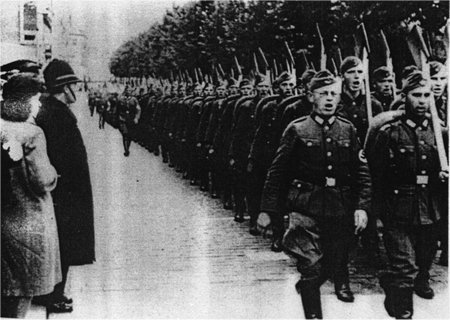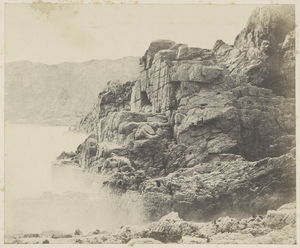Introduction
The German occupation of the Channel Islands lasted for most of the Second World War, from 30 June 1940 until their liberation on 9 May 1945. The Bailiwick of Jersey and Bailiwick of Guernseyare two British Crown dependencies in the English Channel, near the coast of Normandy. The Channel Islands were the only part of the British Isles to be occupied by the Wehrmacht (German Armed Forces) during the war.
Anticipating a swift victory over Britain, the occupiers experimented by using a very gentle approach that set the theme for the next five years. The island authorities adopted a similar attitude, giving rise to accusations of collaboration. However, as time progressed the situation grew gradually worse, ending in near starvation for both occupied and occupiers during the winter of 1944–45.

Before the Occupation
Between 3 September 1939, when the United Kingdom declared war against Germany, and 9 May 1940, little changed in the Channel Islands. Conscription did not exist, but a number of people traveled to Britain to join up as volunteers. The horticulture and tourist trades continued as normal; the British government relaxed restrictions on travel between the UK and the Channel Islands in March 1940, enabling tourists from the UK to take morale-boosting holidays in traditional island resorts.[1] On 10 May 1940, Germany attacked the Netherlands, Belgium, and Luxembourg by air and land and the war stepped closer. The Battle of France was reaching its climax on Empire Day, 24 May, when King George VI addressed his subjects by radio, saying, “The decisive struggle is now upon us … Let no one be mistaken; it is not mere territorial conquest that our enemies are seeking. It is the overthrow, complete and final, of this Empire and of everything for which it stands, and after that the conquest of the world. And if their will prevails they will bring to its accomplishment all the hatred and cruelty which they have already displayed.
Evacuation
The realization of the necessity of civilian evacuation from the Channel Islands came very late. With no planning and secrecy being maintained, communications between the island governments and the UK took place in an atmosphere of confusion and misinterpretation. Opinion was divided and chaos ensued with different policies adopted by the different islands. The British government concluded its best policy was to make available as many ships as possible so that islanders had the option to leave if they wanted to.
Emergency Government
The British Home Office instructed the Lieutenant Governors that in the eventuality of the recall of the representatives of the Crown, the Bailiffs should take over their responsibilities, and that the Bailiffs and Crown Officers should remain at their posts. The Lieutenant Governor of Jersey discussed with the Bailiff of Jersey the matter of being required to carry on administration under German orders. The Bailiff considered that this would be contrary to his oath of allegiance, but he was instructed otherwise
Invasion
The Germans did not realise that the islands had been demilitarised (news of the demilitarisation had been suppressed until 30 June 1940),[ and they approached them with caution. Reconnaissance flights were inconclusive. On 28 June 1940, they sent a squadron of bombers over the islands and bombed the harbours of Guernsey and Jersey. In St. Peter Port, the main town of Guernsey, some lorries lined up to load tomatoes for export to England were mistaken by the reconnaissance flights for troop carriers. A similar attack occurred in Jersey where nine died. In total, 44 islanders were killed in the raids. The BBC broadcast a belated message that the islands had been declared “open towns” and later in the day reported the German bombing of the island.

Occupation
The German forces quickly consolidated their positions. They brought in infantry, established communications and anti-aircraft defenses, established an air service with occupied mainland France, and rounded up British servicemen on leave. and the Germans occupied the island of Jersey for 5 years

Liberation
Liberation of the German-occupied Channel Islands Plaque in the Royal Square, St Helier: On 8 May 1945 from the balcony above Alexander Moncrieff Coutanche, Bailiff of Jersey, announced that the island was to be liberated after five years of German military occupation. On 10 May 1985, Her Royal Highness the Duchess of Kent unveiled this plaque to commemorate the Liberation.Although plans had been drawn up and proposed in 1943 by Vice Admiral Lord Louis Mountbatten for Operation Constellation, a military reconquest of the islands, these plans were never carried out. The Channel Islands were liberated after the German surrender.On 8 May 1945 at 10:00 the islanders were informed by the German authorities that the war was over. Churchill made a radio broadcast at 15:00 during which he announced that Hostilities will end officially at one minute after midnight tonight, but in the interests of saving lives the “Cease fire” began yesterday to be sounded all along the front, and our dear Channel Islands are also to be freed today.

HMS Beagle, which had set out at the same time from Plymouth, performed a similar role in liberating Jersey. Two naval officers, Surgeon Lieutenant Ronald McDonald and Sub Lieutenant R. Milne, were met by the harbor master who escorted them to his office where they hoisted the Union Flag, before also raising it on the flagstaff of the Pomme D’Or Hotel. It appears that the first place liberated in Jersey may have been the British General Post Office Jersey repeater station. Mr Warder, a GPO lineman, had been stranded in the island during the occupation. He did not wait for the island to be liberated and went to the repeater station where he informed the German officer in charge that he was taking over the building on behalf of the British Post Office.
Sark was liberated on 10 May 1945, and the German troops in Alderney surrendered on 16 May 1945. The German prisoners of war were removed from Alderney by 20 May 1945, and its population started to return in December 1945, after clearing up had been carried out by German troops under British military supervision.[c
Aftermath
10 May 1945: The restoration of British administration is proclaimed
The main Liberation forces arrived in the islands on 12 May 1945. A Royal Proclamation read out by Brigadier Alfred Snow in both Guernsey and Jersey vested the authority of military government in him. The British Government had planned for the relief and restoration of order in the islands. Food, clothing, pots, pans and household necessities had been stockpiled so as to supply islanders immediately. It was decided that to minimize financial disruption Reichsmarks would continue in circulation until they could be exchanged for sterling.



